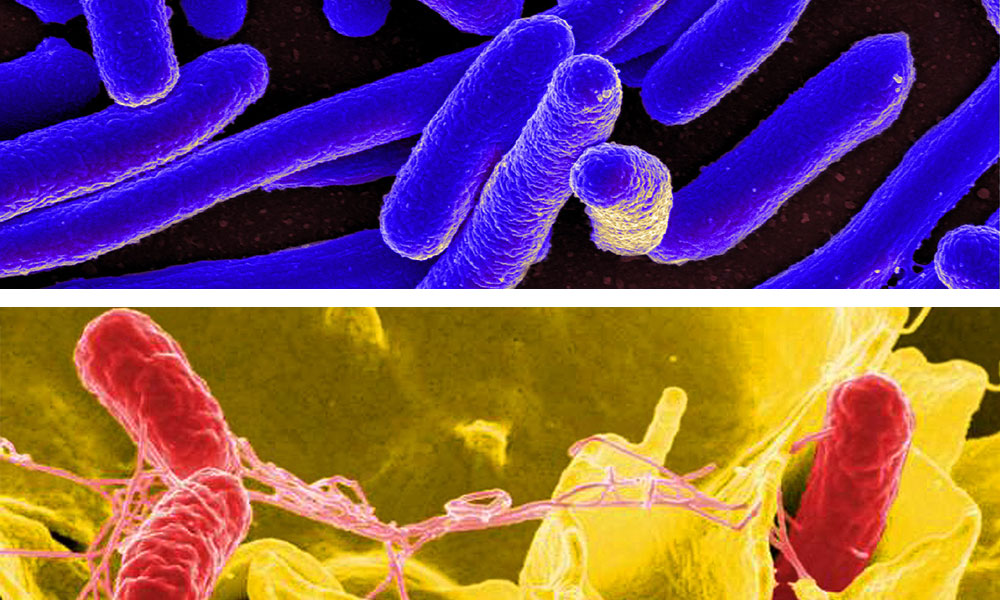Last week, we asked you to determine which common food-borne pathogen, Escherichia coli or Salmonella spp., was causing the enteric infection described in our latest Clinical Case File. The results are in, and we’re proud to share we have some very savvy readers.
Of the 271 votes, 229 (85%) thought Salmonella spp. was the culprit and 42 (15%) pinned the infection on Escherichia coli.
And the correct answer is…Salmonella spp.! All but one of the biochemical tests listed in the case file applied to both organisms.
Hydrogen sulfide (TSI) – Positive
Urease – Negative
Indol – Negative
Methyl Red – Negative
Phenylalanie deaminase – Negative
Salmonella is H2S producing which turns TSIA and XLD agar black, something Escherichia coli doesn’t do.
This case is closed. Thanks to everyone who voted. Read on to learn more about these strains and testing methods clinical laboratories utilize to detect enteric pathogens.
About Escherichia coli (E. coli)
Escherichia coli, often referred to as E. coli, is both a friend and foe. There are often large numbers of this organism that reside in our gastrointestinal tracts and live symbiotically with us as the host. However, E. coli can turn pathogenic and is known as a common cause of sepsis, neonatal meningitis, urinary tract infections and gastroenteritis. The strain’s most common virulence factors include adhesions and exotoxins1.
When E. coli is the cause of gastroenteritis, there have been at least six different pathogenic groups identified1. Each is unique in the way it infects the intestines. These include Enterotoxigenic E. coli (ETEC),Enteropathogenic E. coli (EPEC), Enteroinvasive E. coli (EIEC), Enterohemorrhagic E. coli (EHEC), Enteroaggregative E. coli (EAEC), and Diffuse aggregative E. coli (DAEC)1.
About Salmonella
Salmonella is known to colonize virtually all animals. A few strains are highly adapted to humans and do not infect other species. Most infections caused by Salmonella are the result of ingesting contaminated food or via fecal-oral transmission. Salmonella incidences are most common in children under five years of age or adults over the age of 60. There are four types of Salmonella infections: enteritis, septicemia, enteric fever, and asymptomatic colonization1.
Testing Methods for Enteric Pathogens
In the instance of suspected gastroenteritis, a stool culture is usually ordered. While commonly ordered and easy to perform, culture tests can take precious time to confirm or deny a diagnosis. Molecular diagnostic technologies have emerged and can provide physicians with accurate and fast results that are specific and sensitive to genes produced by enteric pathogens. With test results in under an hour that do not need culture confirmation, physicians can provide appropriate treatment immediately, especially in the case of pediatric patients.
Traditional Culture Methods
Although rapid molecular testing is becoming more common, many clinical laboratories continue to rely on traditional stool cultures for detecting enteric pathogens. With the exception of pediatric patients, the rising cost of molecular testing continues to keep laboratories performing traditional stool cultures.
The emergence of chromogenic media has helped to simplify and reduce the time to proper pathogen identification. Stool cultures include the isolation and identification of the pathogen utilizing various culture media, followed by biochemical profiling for confirmation.
Molecular Diagnostic Methods for Enteric Pathogens
Multiple molecular diagnostic assays are available for the detection of enteric pathogens from a patient’s stool sample.
| Organism Group: | E. coli | Salmonella spp. |
| Description Symptoms: | See symptoms | See symptoms |
| Diagnosis: | See CDC diagnosis | See CDC diagnosis |
| Molecular Diagnostic Assays: | Cepheid Xpert® Carba-R detects IMP, NDM, VIM genes (all can be present in E. coli) BioFire® FilmArray®Gastrointestinal (GI) Panel detects multiple strains of diarrheagenic E. coli VERIGENE® Enteric Pathogens Test detects Shiga toxins 1 and 2 (can be present in E. coli) BD MAX™ Enteric Bacterial Panel detects STEC and EIEC |
VERIGENE® Enteric Pathogens Test detects Salmonella spp. BioFire® FilmArray® Gastrointestinal (GI) Panel detects Salmonella spp. BD MAX™ Enteric Bacterial Panel detects Salmonella spp. |
| Other Molecular Methods of Detection: | qPCR: Learn more | RT-PCR: Learn more |
Whether your laboratory uses traditional methods, molecular methods, or both, precise results cannot be guaranteed without a strong quality control system in place. Microbiologics offers test-ready controls to help you ensure accurate results when testing for enteric pathogens.
View all live culture controls
Additional Resources:
- Brief comparison of E. coli and Salmonella infections by HHS: Read
- Examples of phenotypic differences caused by genetic dissimilarities between E. coli and Salmonella: Read
- ESI-MS differentiation of E. coli and Salmonella: Read
References:
- Wright, Scott. “Enteric Pathogens.” Clinical Microbiology 2213, 6 Feb. 2001. Weber State University. Lecture.
Read Next – Dear Stanley: Assayed vs Unassayed Molecular Controls






0 Comments